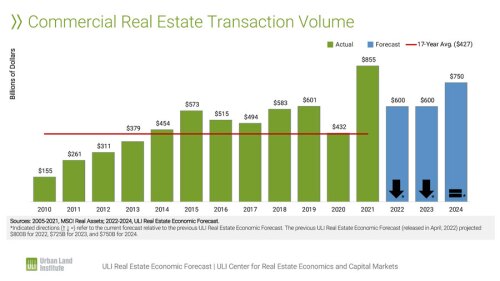COVID-19 is a rare and powerful global disease that has led to a devastating spike in infections and fatalities and has effectively shut down large parts of the U.S. and global economies. Enormous uncertainty exists about how and when it will be cured or treated and how and when economies will approach something resembling normalcy.
Despite these dire conditions, U.S. real estate economists are predicting some light at the end of the tunnel. First, the current economic recession will be short-lived, with above-average gross domestic product (GDP) growth in 2021 and 2022. Second, the impact on real estate market conditions and values will be relatively modest and much less severe than the impact experienced during the global financial crisis (GFC), retail and hotels excluded.
As always, we note a caveat: the Forecast is based on the median responses to a survey of economists, with a wide range of views both better and worse.
A recording of this presentation is available on Knowledge Finder.
While U.S. real estate participants should feel some level of relief from the relatively positive view of future prospects expressed herein, the severity of the current economic downturn and the many unknowns of a global pandemic should temper our views and expectations.
These results are from ULI’s latest Real Estate Economic Forecast, which is based on a May 2020 survey of 39 economists and analysts at 35 leading real estate organizations.
The rapid spread and ensuing economic impact of the COVID-19 virus has been stunning. The conclusions from the prior survey in December 2019 seem to have nothing in common with current views: “There is no end in sight for the long-lived U.S. economic and real estate market expansion, according to leading real estate economists.”
The following are among the May survey’s key findings for commercial real estate:
- Commercial real estate prices as measured by the Real Capital Analytics (RCA) Commercial Property Price Index are projected to fall by 7 percent in 2020, a relatively benign outcome for real estate. Prices fell by 13.6 percent in 2008 and 20.8 percent in 2009 during the GFC. One reason for the milder impact from COVID is that debt financing is expected to be more available than it was during the GFC. For example, issuance of commercial mortgage–backed securities (CMBS) is forecast to be $45 billion in 2020, compared with $3 billion in 2009.
- Total returns from unleveraged core real estate will turn negative this year (–5 percent) but will rebound to 3.2 percent in 2021 and 6.7 percent in 2022. This will be a much better outcome than that experienced during the GFC, when total returns were –6.5 percent in 2008 and –16.8 percent in 2009. There will be a large disparity in returns across property types: the industrial sector will post a positive 2 percent return in 2020, while returns in the retail sector (all formats) are forecast to be –12 percent this year. Equity real estate investment trust (REIT) returns will average –18 percent in 2020 (versus a 38 percent drop in 2008) but are predicted to rally by 10 percent in both 2021 and 2022.
- Wide differences are forecast for market fundamentals depending on property type. Hotels are forecast to suffer the most, with the average occupancy rate plummeting to 40.1 percent in 2020 from 66.1 percent in 2019. Retail also will be hit hard since closures of nonessential stores (in the process of being lifted in some states) has exacerbated struggles by some retailers. The retail availability rate for neighborhood and community centers is forecast to rise 300 basis points to 11.6 percent in 2020, continue to rise in 2021, and essentially plateau in 2022. (It should be noted that the retail availability forecast does not include regional malls, which are likely to perform differently than neighborhood and community centers.) Industrial is forecast to see little impact, with availability rising 60 basis points to 7.8 percent from 2019 to 2020, but dropping to 7.2 percent, among the lowest availability rates of the last 20 years, by 2022. Apartment and office vacancy rates will see modest deterioration in 2020, rising 100 and 230 basis points, respectively, compared with that seen in 2019. Both sectors will see falling vacancy rates by 2022.
- Industrial will lead all property types in rent growth over the 2020–2022 time frame, averaging 2.2 percent per year. Apartment rent growth will fall by 2 percent in 2020 but with an overall three-year positive average of 1 percent. The other major property types will average negative rent growth over the next three years, with hotels at –5.3 percent revenue-per-available-room (RevPAR) growth; retail at –3.1 percent; and office at –1 percent.
- Real estate transaction volumes will fall to $275 billion in 2020, more than 50 percent lower than the 2019 level ($588 billion). While a large decline, forecast transaction volumes over the next three years ($1.175 trillion) show a much healthier capital market environment than that seen during the constrained GFC era ($408 billion in transaction volume from 2008 to 2010).
- Single-family housing starts will drop to 650,000 in 2020, a 27 percent drop from the prior year, but well ahead of the GFC nadir of 431,000 in 2011. Home price growth is forecast to average 1.1 percent in 2020 before improving to 4.6 percent in 2022.
Among the survey’s key findings for major economic indicators:
- The U.S. GDP is forecast to fall by 6 percent this year. This would be the largest single-year decline since 1946 (–11.6 percent) and over twice the peak decline seen during the GFC (–2.5 percent in 2009). A bounce back is expected in 2021 and 2022, with forecast GDP growth of 3.9 percent and 3.6 percent, respectively, both well above the long-term average of 2.1 percent.
- Net job growth is expected to be negative 10 million for 2020 (full year), compared to a two-year decline of 8.6 million in 2018 and 2019. This estimate implies a very meaningful recovery later this year, since COVID-related unemployment claims are already close to 36 million. The job recovery will continue at a strong pace in ensuing years, with forecast growth of 4 million net jobs in 2021 and 2022. This job growth will not be sufficient to move the unemployment rate back to the 2019 level of 3.5 percent. The Forecast calls for the U.S. unemployment rate to jump to 11.3 percent at year-end 2020, and then decline to the long-term average (5.9 percent) by the end of 2022.
- Yields on the 10-year U.S. Treasury note are expected to stay very low this year and gradually move up but remain well below long-term averages. The year-end 2020 yield is predicted to be 0.8 percent, close to the current yield, moving up to 1.7 percent in 2022, well below the long-term average of 3.3 percent.
As shown in the table below, leading U.S. real estate economists expect that while the top-line economic impact of COVID-19 will be much worse than the global financial crisis, U.S. real estate market fundamentals and values will fare much better compared to that era. Among real estate indicators, only retail and hotel are expected to suffer a worse outcome, while most property type returns and market fundamentals will perform much better than they did during the GFC.
Although the above comments reflect the consensus view of leading real estate economists, the level of conviction around these forecasts is much lower than normal. Comments provided by respondents point to the precarious nature of the disease, governmental responses, and future actions by consumers and investors who have never experienced a global pandemic.
COVID-19 Forecast Compared with Global Financial Crisis(Based on Most Affected Year)



